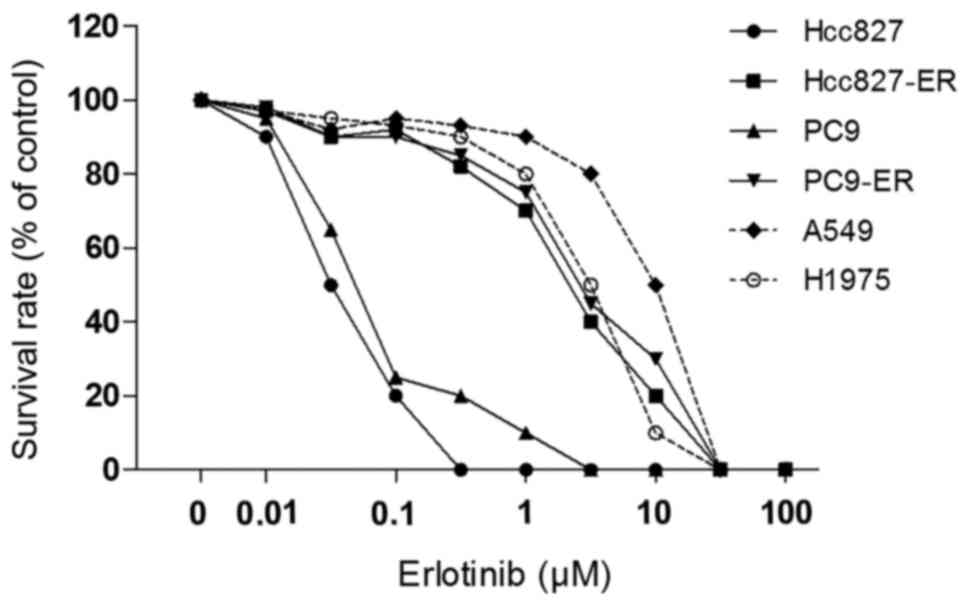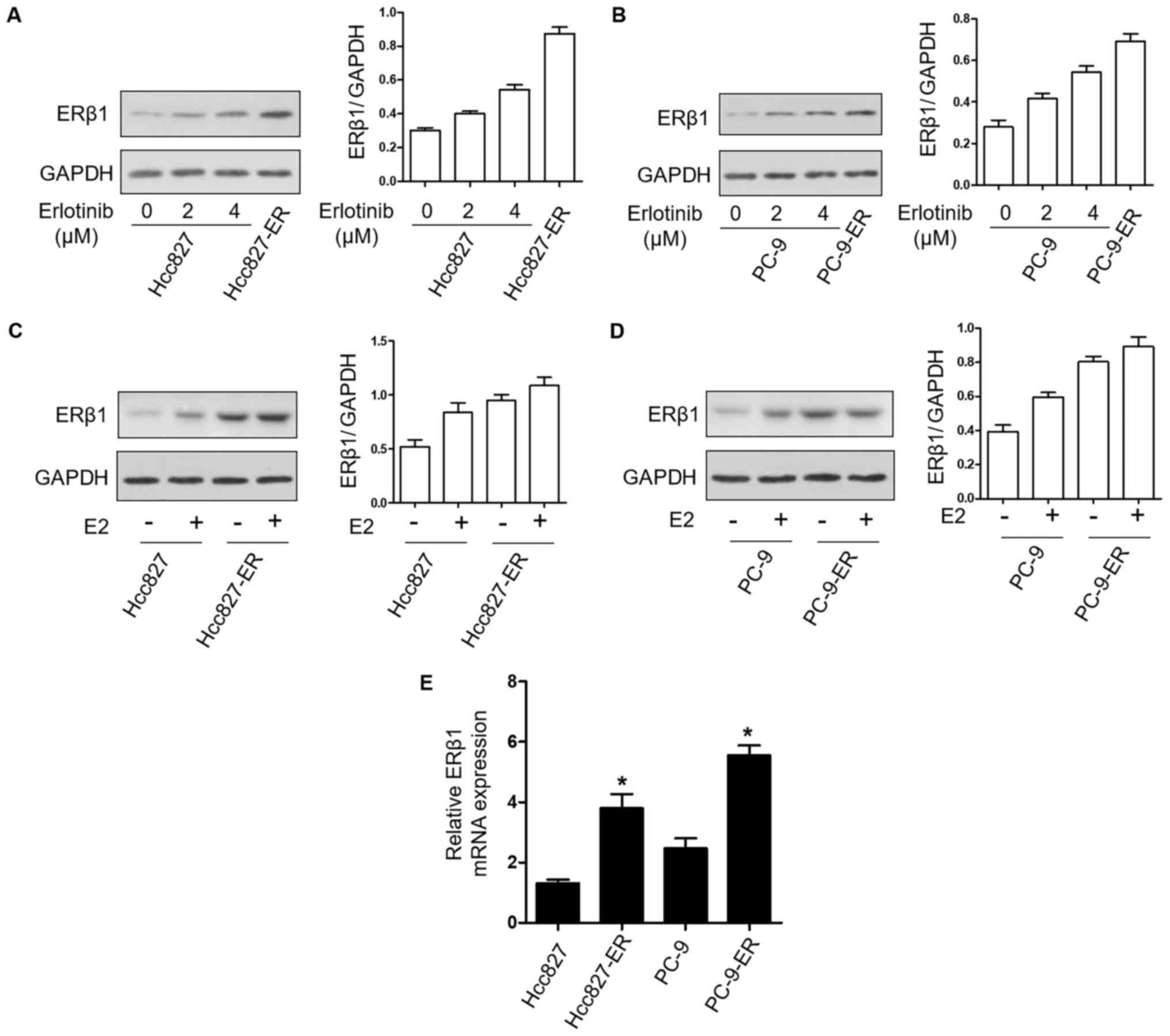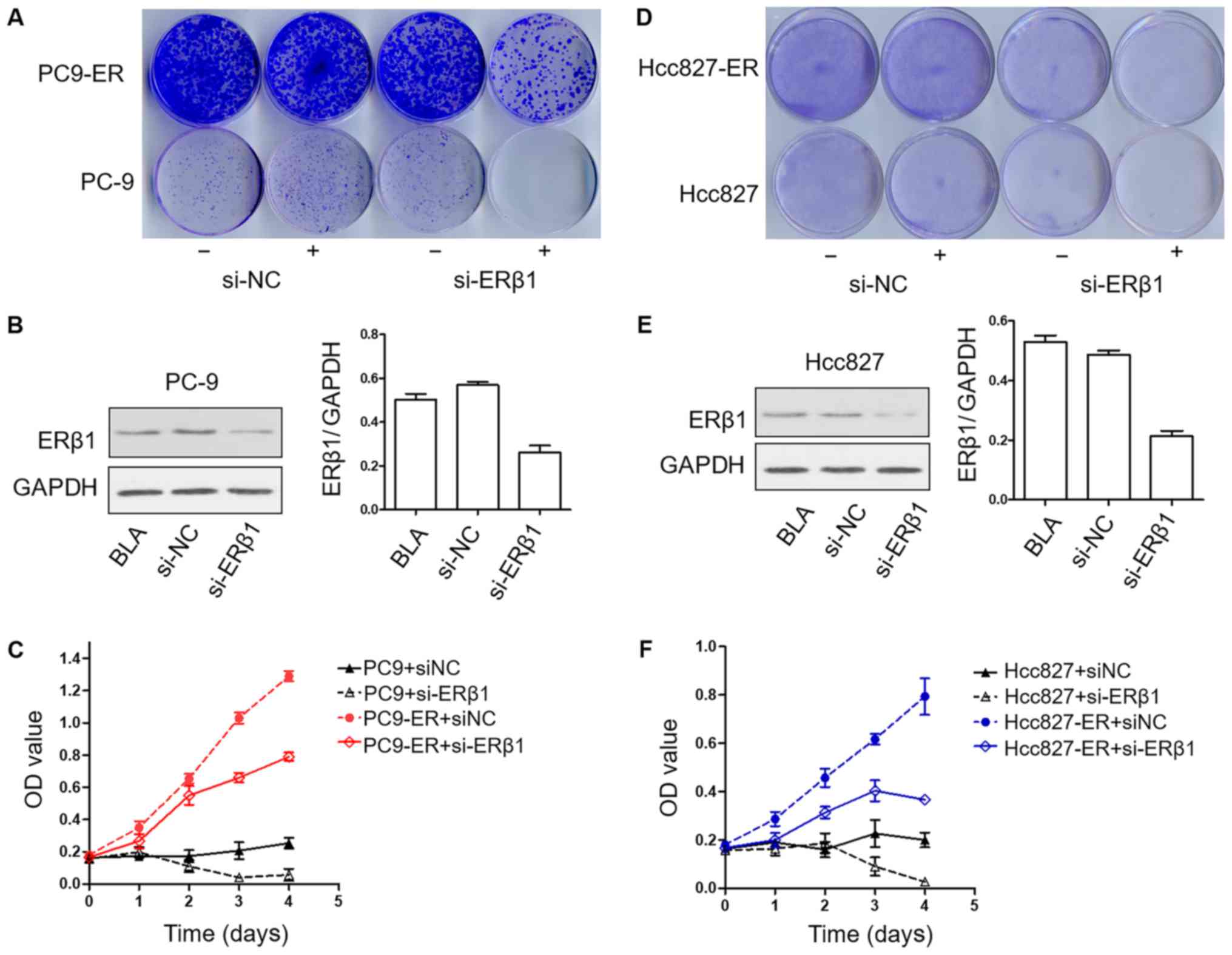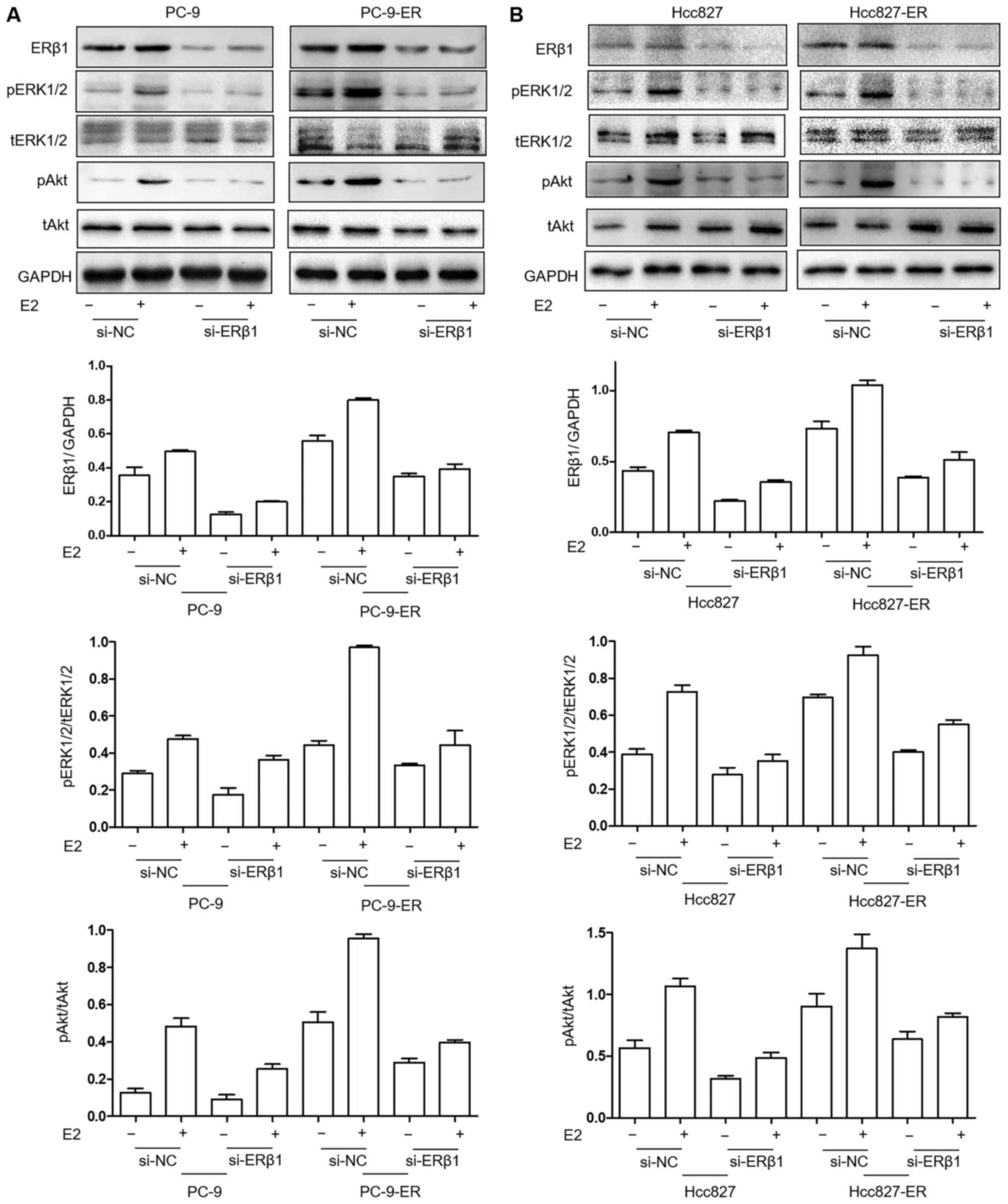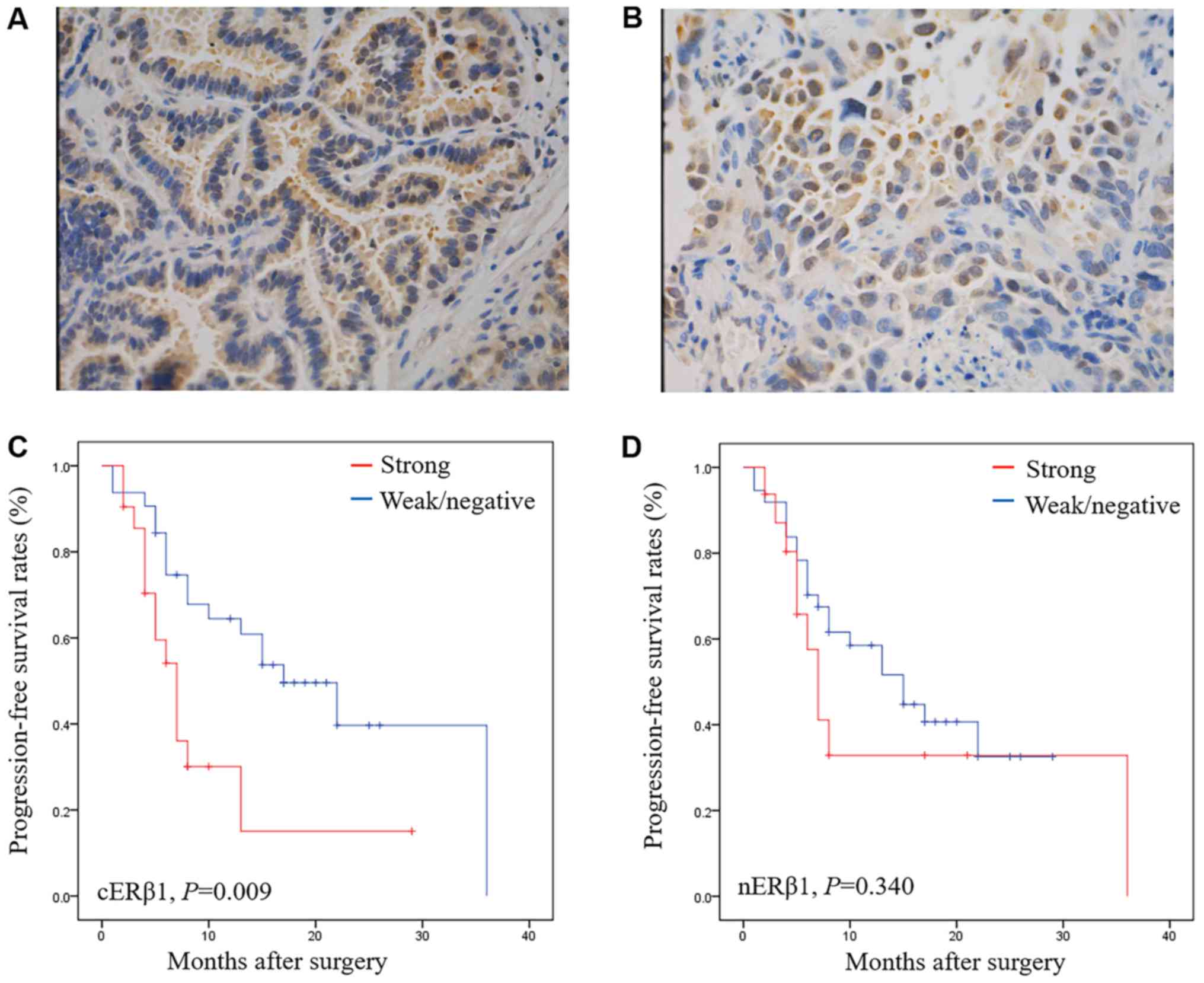Estrogen receptor β1 activation accelerates resistance to epidermal growth factor receptor-tyrosine kinase inhibitors in non-small cell lung cancer
- Authors:
- Published online on: January 4, 2018 https://doi.org/10.3892/or.2018.6186
- Pages: 1313-1321
Abstract
Introduction
The efficacy of epidermal growth factor receptor-tyrosine kinase inhibitors (EGFR-TKIs), such as gefitinib and erlotinib, in non-small cell lung cancer (NSCLC) therapy has been widely demonstrated (1). Patients with EGFR-sensitizing mutations treated with EGFR-TKIs have a significantly longer progression-free survival (PFS) compared with those treated with standard chemotherapy (1,2). However, despite an excellent initial response, drug resistance eventually develops in the majority of patients, limiting the mean drug-response duration to less than 1 year (3).
The estrogen receptor (ER) pathway is among the most well-studied pathways in breast cancer. Data on ER signaling in lung cancer have increased in recent decades. In the Women's Health Initiative, more than 16,000 postmenopausal women with an intact uterus and no breast cancer history were randomly allocated to supplemental estrogen and progesterone or no hormone replacement therapy (HRT). After 5.6 years of study and 2.4 years of follow-up, the hazard ratio for lung cancer incidence in the HRT group was 1.28 (P=0.12), and the hazard ratio for death in patients with NSCLC and death specifically from NSCLC was 1.61 (P=0.02) and 1.87 (P=0.004), respectively (4). Furthermore, a prospective cohort study confirmed an increased, dose-dependent lung cancer risk among women who received HRT (5). Commonly expressed in patients with NSCLC, human NSCLC cell lines, and mouse models, ERβ is the major functional receptor of lung cancer (6,7).
Evidence supports an interaction between EGFR and ERβ pathways in the development of lung cancer. Aromatase is a candidate prognostic factor in patients with lung adenocarcinoma, particularly in those with EGFR mutations, and may also be a beneficial therapeutic target in these patients (8). The combination of anastrozole and gefitinib compared with either drug alone maximally inhibits cell proliferation, induces apoptosis, and affects downstream signaling pathways (9). Fulvestrant adds to the effects of EGFR inhibitors, including synergy in the EGFR-mutant, erlotinib-resistant H1975 cell line. Tumor stability is achieved in human tumor xenografts with either fulvestrant or EGFR inhibitors, but tumors regress significantly when both pathways are inhibited (10). However, the function of the full-length ERβ protein, ERβ1, in resistance to EGFR-TKIs in NSCLC is still unknown.
Therefore, the present study proposed that ERβ1 activation accelerates the resistance to EGFR-TKIs in NSCLC. Secondary TKI-resistant cell lines, PC9-ER and Hcc827-ER, and xenografts were established to investigate the function of ERβ1 in secondary resistance progression and efficiency by targeting ERβ1 to reverse resistance. Furthermore, the correlations between ERβ1 and follow-up outcome after EGFR-TKI therapy were analyzed in 53 patients with advanced NSCLC and in tumors biopsy confirmed with EGFR-sensitive mutants. The results established the activation and potential therapeutic effects of ERβ1 in NSCLC with resistance to EGFR-TKIs via the bypass signals of extracellular signal-regulated protein kinases 1 and 2 (ERK1/2) and Akt pathways.
Materials and methods
Cells and reagents
The human NSCLC cell lines Hcc827 and PC9 were purchased from the American Type Culture Collection (ATCC; Manassas, VA, USA). These cells were cultured under a humidified atmosphere of 5% CO2 at 37°C in RPMI-1640 medium (11835–030; Thermo Fisher Scientific, Inc., Waltham, MA, USA) supplemented with 10% fetal bovine serum (FBS). Erlotinib was kindly provided by Roche (Mannheim, Germany) and fulvestrant (129453-61-8) was purchased from Cayman Chemical (Ann Arbor, MI, USA). Erlotinib-resistant Hcc827-ER and PC9-ER cells were selected from a subculture that had acquired resistance to erlotinib using the following procedure. Cultured Hcc827 and PC9 cells were maintained in a medium containing 0.2 µM erlotinib for 7 days. After exposure to erlotinib, they were washed and cultured in drug-free medium for 14 days. Upon an increase in viable cells, they were seeded in a medium with an increasing concentration of erlotinib, from 0.4 to 4 µM, on 24-well culture plates for subcloning until a single clone was obtained. Then, EGFR mutations were detected by ARMS EGFR Mutation Detection kit (Amoy Dx, Shenzhen, China). Mutations of the PC9-ER Hcc827-ER were found to include E746-A750del. The cells were transfected with siRNA-ERβ1 using Lipofectamine 2000 according to the manufacturers protocol. siRNA-ERβ1 oligos were ordered from Invitrogen (Shanghai, China): siRNA-ERβ1 sense sequence, CAGAUACUCUUUU AGACCATT; antisense sequence, UGGUCUAAAAGAGU AUCGTG), and a scrambled siRNA.
Ethical approval
All procedures performed in studies involving human participants were in accordance with the ethical standards of the Institutional and/or National Research Committee and with the 1964 Helsinki Declaration and its later amendments or comparable ethical standards. All applicable international, national and/or institutional guidelines for the care and use of animals were followed.
Cell viability and proliferation analysis
For short-term cell viability assays, 3,000 cells were seeded in triplicate into 96-wells for 1 day, and then incubated for 5 days with various concentrations of erlotinib and fulvestrant. Nine duplicate wells were used for each group. At the end of the culture period, the viability of the cells was measured using the Cell Counting Kit-8 (CCK-8) assay according to the manufacturer's instructions. In brief, 90 µl of fresh serum-free medium and 10 µl of CCK-8 reagent were added to each well after decanting the old medium, and the culture was continued at 37°C for 2 h. The optical density at 450 nm was measured using a microplate reader (Promega, Madison, WI, USA).
For long-term colony formation assays, 100,000-200,000 cells were plated/3-cm well the day before the start of treatment. The cells were retreated with fresh media with or without erlotinib and fulvestrant every 3 days until the appropriate confluence, as estimated by the control conditions, was reached. Each experiment was performed in triplicate. The plates were stained with 0.2% crystal violet/10% formalin, and the cell number was estimated under a microscope.
Quantitative real-time PCR
PC9, PC9-ER and Hcc827-ER cells were plated in 60-mm-diameter cell culture dishes. Total RNA was isolated from the cells using TRIzol reagent (Invitrogen, Carlsbad, CA, USA) according to the manufacturers instructions. Complementary DNA (cDNA) was synthesized from total RNA with Oligo(dT), Enzyme Mix and primers (Invitrogen). The primer sequences used were as follows: forward primer, 5′-GTCAGGCATGCGAGTAACAA-3′, reverse primer, 5′-GGGAGCCCTCTTTGCTTTTA-3′. For amplification, cDNA was initially denatured at 95°C for 10 min, 40 cycles of 95°C for 15 sec, 60°C for 35 sec, and 72°C for 40 sec (ABI PRISM 7300 Sequence Detection system). For each PCR reaction, a cDNA standard curve was used to generate relative expression changes in ER mRNA levels, which were normalized to the β-actin gene.
Western blotting
The cells were detached using trypsin, washed three times with phosphate-buffered saline, treated with lysis buffer [25 mM Tris-HCl pH 7.4, 1% Triton X-100, 150 mM NaCl, 5% ethylenediaminetetraacetic acid, 10 mM NaF, 1 mM phenylmethylsulfonyl fluoride (PMSF), and 10 mg of aprotinin and leupeptin], and incubated for 30 min on ice. Lung cancer tissues were lysed in PMSF, followed by homogenization and determination of the concentration of protein. The lysate was centrifuged for 10 min at 12,000 rpm, and the supernatant was collected. The concentrations of protein were measured using the Bradford method (Bio-Rad, Hercules, CA, USA). A 50 µg aliquot of protein/lane was electrophoresed on an 8–12% sodium dodecyl sulfate-polyacrylamide gel and electroblotted on polyvinylidene fluoride membranes (Millipore, Billerica, MA, USA). The transferred membranes were blocked with 5% non-fat dry skimmed milk in Tris-buffered saline (TBST) (25 mM Tris-HCl pH 7.4, 125 mM NaCl, 0.05% Tween-20) and incubated at 4°C overnight with the appropriate primary antibodies, which were specific for the following proteins: ERβ1 (MCA1974ST; 1:500) (Serotec Biologicals, Raleigh, NC, USA). After being washed with TBST, the membranes were incubated with a horseradish peroxidase-labeled secondary antibody (1:2,000) for 1 h at 37°C before detection using ECL Plus Western Blotting Detection Reagents (Pierce, Rockford, IL, USA). Glyceraldehyde 3-phosphate dehydrogenase was used as an internal control for protein loading and analysis.
Tumor xenograft model
PC9-ER (5.0×106 cells/mouse) cells were subcutaneously implanted into the posterior flank of 4-week old NOD SCID female mice. The tumor size was monitored as previously described (10). When the average tumor size reached 50 mm3, erlotinib (10 mg/kg) and/or fulvestrant (10 mg/kg) were subcutaneously administered twice per week. After 22 days, the mice were sacrificed and the tumors were collected and divided into two groups. One group was fixed in 10% formalin and embedded in paraffin for pathological examinations and immunohistochemical analysis, and the other group was stored in liquid nitrogen, and then at −80°C for further use (western blot analysis). The aforementioned measurements were performed by two qualified technicians in a double-blinded manner, and the mean of the two scores was obtained.
Patient selection and immunohistochemistry
The present study included 53 Chinese patients with advanced NSCLC who received EGFR-TKI therapy at the Tongji Hospital between July 2012 and December 2015. All diagnoses were histologically confirmed and evaluated as stage IV according to the current Tumor-Node-Metastasis (TNM) Staging System (IASLC 2009). Only patients with sufficient tissue for both EGFR mutation analysis and ERβ1 immunohistochemical staining were enrolled after obtaining appropriate approval from the Institutional Review Board (IRB) (IRB ID no. 20141101). Full consent was obtained from patients involved in the present study. Clinicopathological information from the patients was collected, and the database was tabulated in an anonymous manner. Responses were classified using standard Response Evaluation Criteria in Solid Tumors, version 1.1. The PFS was assessed from the first day of EGFR-TKI treatment until radiologic progression or death. Immunohistochemical staining was performed using an ERβ1 antibody, which was confirmed to be specific (11). Cells positive for ERβ1 appeared yellow or yellowish brown in the nucleus or cytoplasm, or they contained yellowish brown granules. A pathological examination and semi-quantitation based on the staining intensity and proportion of positive cells were performed as previously described (12,13).
Statistical analysis
Data are expressed as mean ± standard deviation from three independent experiments. Comparisons among groups were performed with the analysis of variance. A P-value of <0.05 was considered to indicate a statistically significant result. Statistical tests were performed using SPSS 13.0 (SPSS, Inc., Chicago, IL, USA).
Results
Expression of ERβ1 is upregulated following resistance to erlotinib, with β-estradiol dependence
First, the effect of erlotinib on six NSCLC cell lines was compared using the CCK-8 assay. Four of the six NSCLC cell lines showed considerable resistance to erlotinib. Dose-response curves to erlotinib for all cell lines assessed by the colony formation assay are presented in Fig. 1. Among the six NSCLC lines, A549, H1975, PC9-ER and Hcc827-ER showed 100- to 200-fold greater resistance to erlotinib compared with the PC9 and Hcc827 cells. The drug sensitivity of all six human cancer cell lines to erlotinib and fulvestrant was examined using the CCK-8 assay, and the IC50 values are presented in Table I. The IC50 values of Hcc827 to erlotinib and fulvestrant were 0.03±0.01 and 7.93±0.87, and the IC50 values of PC-9 were 0.05±0.002 and 8.05±1.22, respectively. A549, H1975, PC9-ER and Hcc827-ER cells had 100-fold or greater resistance to erlotinib (Table I).
Table I.Sensitivities to erlotinib and fulvestrant as assessed by CCK-8 assay in Hcc827 (19-Del), Hcc827-ER (19-Del), PC9 (19-Del), PC9-ER (19-Del), A549 (WT) and H1975 (L858R/T790M) cells. |
To determine the effects of erlotinib resistance on the expression of ERβ1 protein in NSCLC cell lines, the expression of ERβ1 was examined by western blotting in PC9 and Hcc827 cell lines treated with the indicated concentrations of erlotinib and in PC9-ER and Hcc827-ER cells. ERβ1 had higher expression with increasing erlotinib concentrations; the expression was the highest in the PC9-ER and Hcc827-ER cells (Fig. 2A and B). In addition, in the PC9 and PC9-ER cells as well as in the Hcc827 and Hcc827-ER cells, treatment with 10 nM E2 upregulated the expression of ERβ1 (Fig. 2C and D). Additionally, ERβ1 mRNA levels were also higher in the resistant cells compared to levels noted in the parental cell lines (Fig. 2E). These results indicated that the expression of ERβ1 was upregulated after resistance to erlotinib, with β-estradiol dependence.
PC9-ER and Hcc827-ER cell lines are sensitive to erlotinib after downregulation of the expression of ERβ1
To determine the effects of ERβ1 knockdown on the development of resistance to erlotinib in long-term colony formation assays, PC9, PC9-ER, Hcc827 and Hcc827-ER cells were cultured in erlotinib in the presence or absence of siRNA-NC or siRNA-ERβ1 until colonies were formed. Strikingly, in this long-term assay, ERβ1 knockdown strengthened the effects to erlotinib in the PC9-ER and Hcc827-ER cells. Notably, the knockdown of ERβ1 was also effective when induced in PC9 and Hcc827 cells, that is, after initial erlotinib treatment for 14 days (Fig. 3A, B, D and F). To confirm the biological effects of ERβ1 knockdown, viability of the PC9, PC9-ER, Hcc827 and Hcc827-ER cells was assessed using CCK-8 assay after treatment as indicated. Downregulation of ERβ1 induced both PC9-ER and Hcc827-ER cells to grow slower when compared to the control group. In addition, ERβ1 knockdown induced the lowest proliferation in PC9 and Hcc827 groups (Fig. 3C and F), showing that the proliferation of both sensitive and resistant cell lines was suppressed by erlotinib after the downregulation of the expression of ERβ1.
ERK1/2 and Akt pathways are decreased following the silencing of the expression of ERβ1 in PC9-ER and Hcc827-ER cell lines
In an effort to investigate the signaling involved in the re-sensitization to erlotinib treatment after ERβ1 silencing in PC9-ER cells, the expression levels of tERK1/2 (4695), pERK1/2 (4376) (both from Cell Signaling Technology, Inc., Danvers, MA, USA), tAkt (BS1810) and pAkt (BS4007) (both from Bioworld Technology, Inc., Nanjing, China) were evaluated in PC9, PC9-ER, Hcc827 and Hcc827-ER cells. The levels of pERK1/2 and pAkt were decreased by siRNA-ERβ1 treatment in the PC9-ER and Hcc827-ER cells. Levels were the lowest in the PC9 (Fig. 4A) and Hcc827 (Fig. 4B) cells. In addition, the lack of E2 strengthened the downregulation of ERK1/2 and Akt pathways by ERβ1-knockdown.
Co-treatment of erlotinib and fulvestrant results in better tumor inhibition efficiency in PC9-ER cell-derived xenografts compared with treatment of each agent alone
NOD SCID mice harboring tumors derived from human NSCLC PC9-ER cells were randomly assigned to a vehicle control, erlotinib 10 mg/kg, fulvestrant 10 mg/kg (subcutaneously) groups for a total of 22 days. Erlotinib and fulvestrant alone delayed tumor growth. However, treatment with both erlotinib and fulvestrant elicited significantly reduced tumor volume compared with all other treatments (P<0.001), with minimal tumors after several weeks of therapy (Fig. 5A and B). The expression of pERK and pAkt in tumor tissues was lower in the single-drug group, and it was the lowest in the co-inhibition group (Fig. 5C). Consistent with the observations concerning tumor size, the combination (erlotinib plus fulvestrant) led to the inhibition of the expression of ERβ1 in tumor tissues (Fig. 5D).
Strong expression of cERβ1 is related to a shorter PFS in EGFR-TKI-treated patients
A total of 53 patients with NSCLC treated with EGFR-TKIs were analyzed. Most patients were never/light smokers (40, 75.47%) and had adenocarcinoma (46, 86.79%). A total of 48 patients (90.57%) carried EGFR-sensitizing mutations (19-Del or L858R). The expression of ERβ1 was positive in 79.24% (42/53) of the patients with different intracellular distribution patterns, including nuclear (nERβ1) and cytoplasmic (cERβ1) ERβ1 (Fig. 6A and B). No significant correlations were observed between the expression of ERβ1 and EGFR mutations (P=0.093) or sex (P=0.370). Moreover, neither nuclear nor cytoplasmic expression of ERβ was associated with sex (P=0.586, and P=0.105, respectively) or any other clinicopathological characteristic (data not shown).
At the time of data collection (Jan 1, 2016), 31 patients (58.59%) presented with progressive disease. Notably, patients with strong expression of cERβ1 had a poorer PFS after EGFR-TKI treatment (P=0.009) compared with those with weak or without expression (P=0.009) (Fig. 6C and D). Strong nERβ1 immunoreactivity was not significantly associated with worse PFS (P=0.340). When categorized by positive or negative expression of ERβ1, no statistical significance was achieved in the PFS in the nuclear or cytoplasmic expression subgroup. By Cox multivariate analysis, strong expression of cERβ1 was found to be independent factors predicting worse prognosis [P=0.019, (hazard ratio) HR=2.547, 95% confidence interval (CI) 1.165–5.564], which were in agreement with our Kaplan-Meier plots (Table II).
Discussion
In the present study, secondary resistant cell lines were constructed, and it was demonstrated that ERβ1 upregulation occurred following the development of resistance to EGFR-TKIs, accompanied by the activation of ERK1/2 and Akt signals. Fulvetrant plus erlotinib reversed TKI resistance in vitro and in vivo, revealing a new approach to overcome EGFR-TKI resistance. Consistently, patients given EGFR-TKI therapy exhibited a longer PFS in subpopulations with lower expression of cERβ1. The present study discovered a new mechanism of EGFR-TKI resistance from a gender perspective.
The aim of the present study was to investigate the mechanism of acquired resistance to EGFR-TKIs and explore strategies to overcome the resistance to EGFR-TKIs from a gender perspective. Following stimulation with increasing concentrations of erlotinib, the expression of ERβ1 in PC9 and Hcc827 cells was found to be gradually upregulated, consistent with the progressive resistance. Established with the stepwise escalation of EGFR-TKI concentration, PC9-ER, and Hcc827-ER cells had 100-fold or greater resistance compared to sensitive sublines respectively, as previously described (14). In addition, following knockdown of ERβ1, pERK1/2 and pAkt were decreased in the PC9-ER and Hcc827-ER cells. These findings suggest that ERK1/2 and Akt pathways are activated following resistance-induced ERβ1 upregulation. EGFR-TKIs may alter ERβ1 expression through the ERK1/2 and Akt pathways, the bidirectional signaling between ERβ1 and EGFR. Several mechanisms are believed to be responsible for acquired resistance to EGFR-TKIs, including secondary EGFR T790M and minor mutations, MET amplification, activation of MET/HGF axis, acquisition of an epithelial-to-mesenchymal transition signature, and transformation from nNSCLC to small cell lung cancer (SCLC) (14). In addition, the present study demonstrated that ERβ1 upregulation following resistance with activation of the ERK1/2 and Akt pathways, may be another mechanism in EGFR-TKI resistance.
The present study revealed that a combination of erlotinib and a novel ERβ inhibitor fulvestrant significantly inhibited the growth of PC9-ER xenografts in nude mice. Additional treatment of fulvestrant could overcome secondary resistance to EGFR-TKIs in vivo. Strategies for overcoming EGFR-TKI resistance include targeting T790M EGFR or other receptor TKs, alternatively activated bypass pathway molecules, and various downstream signaling molecules. The present study demonstrated a better efficiency by co-treatment of erlotinib and fulvestrant compared with alternatives, and complementary application of fulvestrant reversed resistance to erlotinib in vitro and in vivo. A combination with fulvestrant may provide a prolonged effectiveness of EGFR-TKIs within the range of tolerated toxicity. Previous studies also revealed that a combination of anastrozole and gefitinib compared with either drug alone can maximally inhibit cell proliferation, induce apoptosis and affect downstream signaling pathways (14). Fulvestrant adds to the effects of EGFR inhibitors, including synergy in the EGFR-mutant, erlotinib-resistant H1975 cell line. Tumor stability is achieved in human tumor xenografts with either fulvestrant or EGFR inhibitors, but tumors regress significantly when both pathways are inhibited (10). However, more targeted applications with different genetic abnormalities in a heterogeneous tumor population warrant further exploation. The targeted inhibition strategy from a gender perspective provides a new idea for the clinical treatment of EGFR-TKI resistance.
Patients with strong expression of cERβ1 had a poorer PFS after EGFR-TKI treatment. No statistical significance was achieved in the median PFS between strong nERβ expression and weak/negative expression. Numerous published reports have examined the ER status in relation to the survival of patients with NSCLC (11). High cERβ1 staining was identified as a negative prognostic factor for lung cancer, independent of other prognostic factors (15). nERβ1 positivity was observed in the majority of lung cancer cases (15,16) and found to be a favorable prognostic indicator in various studies. Moreover, lack of nuclear ERβ or the loss of EGFR expression were reported to be independent prognosis markers associated with shorter overall survival (17). However, most studies used antibodies to total ERβ that could not distinguish different ERβ isoforms. In addition, previous studies involving ERβ and EGFR signals rarely identified the difference in ER subtypes.
In conclusion, ERβ1 activation may accelerate EGFR-TKI resistance. Co-targeting ERβ1 can re-sensitize resistant cell lines. Anti-estrogen treatment may be a potential strategy with which to reverse TKI resistance.
Acknowledgements
The present study was funded by the National Natural Science Foundation of China (NSFC), (grant nos. 81272590 and 81402163), the Natural Science Foundation of Hubei Province (grant no. 2014CFB152) and the Wuhan Municipal Human Resources and Social Security Bureau (grant no. 2011415).
References
|
Maemondo M, Inoue A, Kobayashi K, Sugawara S, Oizumi S, Isobe H, Gemma A, Harada M, Yoshizawa H, Kinoshita I, et al North-East Japan Study Group, : Gefitinib or chemotherapy for non-small-cell lung cancer with mutated EGFR. N Engl J Med. 362:2380–2388. 2010. View Article : Google Scholar : PubMed/NCBI | |
|
Rosell R, Carcereny E, Gervais R, Vergnenegre A, Massuti B, Felip E, Palmero R, Garcia-Gomez R, Pallares C, Sanchez JM, et al Spanish Lung Cancer Group in collaboration with Groupe Français de Pneumo-Cancérologie and Associazione Italiana Oncologia Toracica, : Erlotinib versus standard chemotherapy as first-line treatment for European patients with advanced EGFR mutation-positive non-small-cell lung cancer (EURTAC): A multicentre, open-label, randomised phase 3 trial. Lancet Oncol. 13:239–246. 2012. View Article : Google Scholar : PubMed/NCBI | |
|
Lin JJ, Cardarella S, Lydon CA, Dahlberg SE, Jackman DM, Jänne PA and Johnson BE: Five-year survival in EGFR-mutant metastatic lung adenocarcinoma treated with EGFR-TKIs. J Thorac Oncol. 11:556–565. 2016. View Article : Google Scholar : PubMed/NCBI | |
|
Bouchardy C, Benhamou S, Schaffar R, Verkooijen HM, Fioretta G, Schubert H, Vinh-Hung V, Soria JC, Vlastos G and Rapiti E: Lung cancer mortality risk among breast cancer patients treated with anti-estrogens. Cancer. 117:1288–1295. 2011. View Article : Google Scholar : PubMed/NCBI | |
|
Chlebowski RT, Schwartz AG, Wakelee H, Anderson GL, Stefanick ML, Manson JE, Rodabough RJ, Chien JW, Wactawski-Wende J, Gass M, et al: Women's Health Initiative Investigators: Oestrogen plus progestin and lung cancer in postmenopausal women (Women's Health Initiative trial): A post-hoc analysis of a randomised controlled trial. Lancet. 374:1243–1251. 2009. View Article : Google Scholar : PubMed/NCBI | |
|
Tang H, Liao Y, Xu L, Zhang C, Liu Z, Deng Y, Jiang Z, Fu S, Chen Z and Zhou S: Estrogen and insulin-like growth factor 1 synergistically promote the development of lung adenocarcinoma in mice. Int J Cancer. 133:2473–2482. 2013. View Article : Google Scholar : PubMed/NCBI | |
|
Słowikowski BK, Lianeri M and Jagodziński PP: Exploring estrogenic activity in lung cancer. Mol Biol Rep. 44:35–50. 2017. View Article : Google Scholar : PubMed/NCBI | |
|
Kohno M, Okamoto T, Suda K, Shimokawa M, Kitahara H, Shimamatsu S, Konishi H, Yoshida T, Takenoyama M, Yano T, et al: Prognostic and therapeutic implications of aromatase expression in lung adenocarcinomas with EGFR mutations. Clin Cancer Res. 20:3613–3622. 2014. View Article : Google Scholar : PubMed/NCBI | |
|
Shen L, Li Z, Shen S, Niu X, Yu Y, Li Z, Liao M, Chen Z and Lu S: The synergistic effect of EGFR tyrosine kinase inhibitor gefitinib in combination with aromatase inhibitor anastrozole in non-small cell lung cancer cell lines. Lung Cancer. 78:193–200. 2012. View Article : Google Scholar : PubMed/NCBI | |
|
Garon EB, Pietras RJ, Finn RS, Kamranpour N, Pitts S, Márquez-Garbán DC, Desai AJ, Dering J, Hosmer W, von Euw EM, et al: Antiestrogen fulvestrant enhances the antiproliferative effects of epidermal growth factor receptor inhibitors in human non-small-cell lung cancer. J Thorac Oncol. 8:270–278. 2013. View Article : Google Scholar : PubMed/NCBI | |
|
Siegfried JM and Stabile LP: Estrongenic steroid hormones in lung cancer. Semin Oncol. 41:5–16. 2014. View Article : Google Scholar : PubMed/NCBI | |
|
Tang H, Liao Y, Chen G, Xu L, Zhang C, Ju S and Zhou S: Estrogen upregulates the IGF-1 signaling pathway in lung cancer through estrogen receptor-β. Med Oncol. 29:2640–2648. 2012. View Article : Google Scholar : PubMed/NCBI | |
|
Liu C, Liao Y, Fan S, Tang H, Jiang Z, Zhou B, Xiong J, Zhou S, Zou M and Wang J: G protein-coupled estrogen receptor (GPER) mediates NSCLC progression induced by 17β-estradiol (E2) and selective agonist G1. Med Oncol. 32:1042015. View Article : Google Scholar : PubMed/NCBI | |
|
Shien K, Toyooka S, Yamamoto H, Soh J, Jida M, Thu KL, Hashida S, Maki Y, Ichihara E, Asano H, et al: Acquired resistance to EGFR inhibitors is associated with a manifestation of stem cell-like properties in cancer cells. Cancer Res. 73:3051–3061. 2013. View Article : Google Scholar : PubMed/NCBI | |
|
Stabile LP, Dacic S, Land SR, Lenzner DE, Dhir R, Acquafondata M, Landreneau RJ, Grandis JR and Siegfried JM: Combined analysis of estrogen receptor beta-1 and progesterone receptor expression identifies lung cancer patients with poor outcome. Clin Cancer Res. 17:154–164. 2011. View Article : Google Scholar : PubMed/NCBI | |
|
Luo Z, Wu R, Jiang Y, Qiu Z, Chen W and Li W: Overexpression of estrogen receptor beta is a prognostic marker in non-small cell lung cancer: A meta-analysis. Int J Clin Exp Med. 8:8686–8697. 2015.PubMed/NCBI | |
|
Mauro LV, Dalurzo M, Carlini MJ, Smith D, Nuñez M, Simian M, Lastiri J, Vasallo B, Bal de Kier Joffé E, Pallotta MG, et al: Estrogen receptor β and epidermal growth factor receptor as early-stage prognostic biomarkers of non-small cell lung cancer. Oncol Rep. 24:1331–1338. 2010.PubMed/NCBI |



